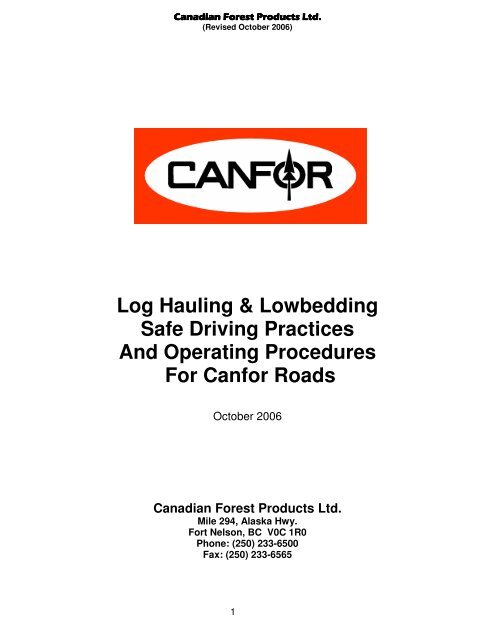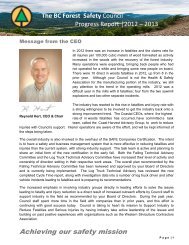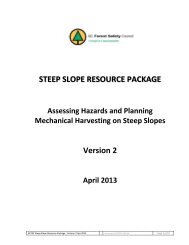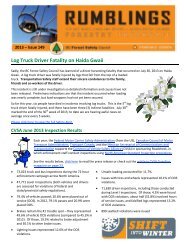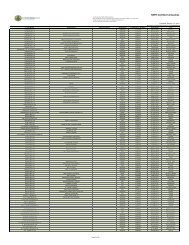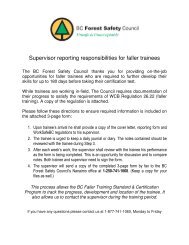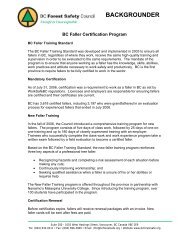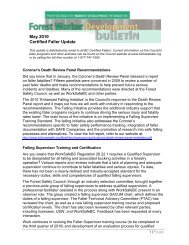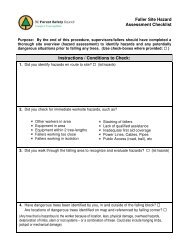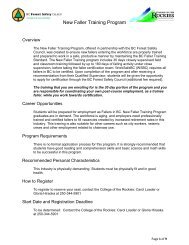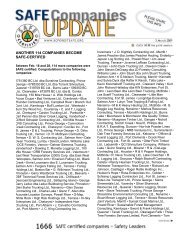Log Hauling & Lowbedding Safe Driving Practices And Operating ...
Log Hauling & Lowbedding Safe Driving Practices And Operating ...
Log Hauling & Lowbedding Safe Driving Practices And Operating ...
Create successful ePaper yourself
Turn your PDF publications into a flip-book with our unique Google optimized e-Paper software.
(Revised October 2006)<br />
<strong>Log</strong> <strong>Hauling</strong> & <strong>Lowbedding</strong><br />
<strong>Safe</strong> <strong>Driving</strong> <strong>Practices</strong><br />
<strong>And</strong> <strong>Operating</strong> Procedures<br />
For Canfor Roads<br />
October 2006<br />
Canadian Forest Products Ltd.<br />
Mile 294, Alaska Hwy.<br />
Fort Nelson, BC V0C 1R0<br />
Phone: (250) 233-6500<br />
Fax: (250) 233-6565<br />
1
(Revised October 2006)<br />
TABLE OF CONTENTS<br />
SAFETY POLICY STATEMENT ..................................................................................3<br />
SUBSTANCE ABUSE POLICY & PROCEDURES ......................................................3<br />
DRIVER QUALIFICATIONS.........................................................................................4<br />
HOURS OF SERVICE..................................................................................................5<br />
LOGGING TRUCK SIGNAGE REQUIREMENTS ........................................................6<br />
WORKSAFE BC REQUIREMENTS - LOGGING TRUCK BULLBOARDS...................7<br />
BC FOREST SAFETY COUNCIL RULES OF THE ROAD ..........................................8<br />
SAFE DRIVING PRACTICES AND PROCEDURES....................................................9<br />
RADIO USAGE ............................................................................................................11<br />
Radio Frequencies....................................................................................................13<br />
SAFETY EQUIPMENT.................................................................................................13<br />
SAFETY INSPECTIONS..............................................................................................13<br />
LOAD SECURITY REQUIREMENTS FOR LOG HAULING AND LOWBEDDING.......14<br />
LOAD WEIGHTS FOR LOG HAULING ....................................................................14<br />
LOADING SPECIFICATIONS FOR LOG HAULING.................................................15<br />
MARKING SPECIFICATIONS......................................................................................17<br />
LOG YARD POLICY.....................................................................................................17<br />
REPORTING OF INCIDENTS......................................................................................18<br />
VIOLATIONS/DISCIPLINE PROCESS ........................................................................18<br />
TRUCK AUDITS...........................................................................................................20<br />
Contractors “<strong>Log</strong> Truck Audits” process: ..................................................................20<br />
Canfor Staff “<strong>Log</strong> Truck Audits” process:..................................................................20<br />
Completing the Truck Audit Form: ............................................................................21<br />
Submission, Review and Presentation of Truck Audit Information: ..........................21<br />
EXPECTATIONS ON: Actions for Non-compliance:.................................................22<br />
EMERGENCY REFERENCE SHEETS........................................................................23<br />
GENERAL ................................................................................................................23<br />
ENVIRONMENTAL (i.e.: landslide)...........................................................................23<br />
EQUIPMENT FIRE ...................................................................................................23<br />
FOREST FIRES........................................................................................................23<br />
MEDICAL AID...........................................................................................................23<br />
VEHICLE ACCIDENT...............................................................................................23<br />
REPORTING INFORMATION FOR VEHICLE ACCIDENT ......................................24<br />
SPILLS INTO WATER OR LARGE (>100 LITRES) SPILLS.....................................24<br />
EMERGENCY RESPONSE CONTACTS – FORT NELSON WOODLANDS...............25<br />
Emergency Aircraft Evacuation Contacts .................................................................26<br />
Emergency Service Response Contacts ..................................................................26<br />
Emergency First Aid Personnel/ Services.................................................................27<br />
DISPATCH INFORMATION FOR HOSPITAL / AIR AMBULANCE ..........................28<br />
FORMS:<br />
Truck Audit<br />
Truck Driver – Sign Off – stays in book<br />
Truck Driver – Sign Off - retained by Contractor and faxed to Canfor Admin<br />
Trucking Registration Form – retained by Contractor and faxed to Canfor Admin<br />
Truck <strong>Safe</strong>ty Inspection Check List – retained by Contractor and faxed to Canfor<br />
Admin<br />
2
SAFETY POLICY STATEMENT<br />
(Revised October 2006)<br />
Canadian Forest Products Ltd., Fort Nelson Woodlands is committed to promoting<br />
attitudes and work conditions that ensure a safe, healthy and productive work environment<br />
throughout all areas of operations. The management team, staff and all contractors are<br />
responsible for carrying out the programs and day to day activities to meet this objective.<br />
It is Canfor’s expectation that every employee and contractor will work cooperatively in<br />
preventing accidents and correcting attitudes or conditions that may lead to an unsafe and<br />
unproductive work environment.<br />
Introduction<br />
The purpose of these safety procedures is to enhance the Worker’s Compensation Board<br />
(WCB), Industrial Health and <strong>Safe</strong>ty Regulations. These safety procedures are<br />
supplementary to the WCB Regulations and do not replace or override those regulations.<br />
This document will be updated annually by CANFOR.<br />
The following safety policies and procedures have been endorsed by CANFOR’s Fort<br />
Nelson Operations that all contractors and road users will ensure the drivers of their trucks<br />
and their sub-contracted trucks delivering logs (or other products) to CANFOR mills<br />
understand and follow these safety policies and procedures. CANFOR is committed to safe<br />
log transportation.<br />
Contractors will be required to review and sign off this document with their log truck drivers<br />
and any sub-contract trucks annually, or upon the hiring of. any new drivers or trucks. The<br />
contractor must submit a copy of the signed document, prior to the commencement<br />
of hauling.<br />
Trucks showing up to a CANFOR scale site without a completed sign off of the <strong>Safe</strong><br />
<strong>Driving</strong> <strong>Practices</strong> and <strong>Operating</strong> Procedures, will not be unloaded.<br />
SUBSTANCE ABUSE POLICY & PROCEDURES<br />
Policy<br />
This policy is applicable to all employees, contractors, contractor employees and<br />
any other individuals providing services to Canfor.<br />
The possession, use, sale or distribution of alcoholic beverages, illegal drugs or<br />
restricted drugs without a prescription on Canfor Fort Nelson Operations’ premises<br />
at any time is prohibited.<br />
No one shall engage in any work for Canfor Fort Nelson Operations in an impaired or<br />
intoxicated condition or under the influence of alcohol or drugs.<br />
No driver shall enter or be permitted to remain on the premises of any Canfor place<br />
of operation or property while his/her ability to work is affected by alcohol, drugs or<br />
3
(Revised October 2006)<br />
other substances. Such an infraction will be subject to Canfor’s or the Contractor’s<br />
substance abuse policies and the RCMP will be contacted for their involvement in<br />
the matter.<br />
Enforcement<br />
Any person who violates this policy will be subject to disciplinary action, up to and including<br />
discharge.<br />
If Canfor or its contractors have reasonable grounds to believe that an employee’s<br />
behaviour or work performance may be adversely affected or that a safety risk is raised as<br />
a result of use of drugs or alcohol on or off duty, the employee will be directed to leave the<br />
Company property immediately with safe transportation provided and may be subject to<br />
testing for the presence of drugs and / or alcohol.<br />
DRIVER QUALIFICATIONS<br />
A detailed list of required qualifications and proof of status is contained on the trucking<br />
registration form included in this book. These documents must be provided to Canfor prior<br />
to the commencement of work. All Contractors are responsible for ensuring that drivers<br />
show knowledge and understanding of Canfor’s <strong>Safe</strong> <strong>Driving</strong> <strong>Practices</strong> and <strong>Operating</strong><br />
Procedures for Canfor Roads.<br />
<strong>Log</strong>ging truck drivers must possess a valid driver’s license as required by the Motor Vehicle<br />
Branch in BC.<br />
Drivers must possess an understanding of the WCB Occupational Health and <strong>Safe</strong>ty<br />
Regulations applicable to their work and must also possess an understanding of the Motor<br />
Vehicle Act & Regulations, Commercial Transport Act & Regulations and the Motor Carrier<br />
Act. Drivers must also comply with Canfor’s Forest Management System (FMS) (see<br />
information found in this book on page). Trucks and trailers must be equipped and<br />
maintained to meet these Regulations.<br />
Canfor recommends all truck drivers obtain a valid First Aid Ticket, Level 1 with the<br />
Transportation Endorsement.<br />
It is imperative that all drivers have a clear understanding of the English language to ensure<br />
safety to all. English is the language used on Canfor roads and property.<br />
All commercial drivers on Canfor roads should be familiar with the information published by<br />
ICBC, Commercial Vehicle Service, Booklets #1 to 6:<br />
1) Information for Commercial Carriers<br />
2) Cargo Security<br />
3) Commercial Vehicle Inspection Program<br />
4) Commercial Vehicle Maintenance Program<br />
5) National Cargo Security<br />
6) National Security Code<br />
4
(Revised October 2006)<br />
These guides are available at the government weigh scales and are also available by<br />
accessing internet website: www.th.gov.bc.ca<br />
All drivers are required to obtain from the ICBC weigh scales an oversize term permit to<br />
allow for empty over-width trailers up to 3.2 m wide to travel on provincial highways and a<br />
highway crossing permit for loaded over-width trailers to cross provincial highways.<br />
Drivers should be knowledgeable of the Town of Fort Nelson Traffic Control Bylaws and<br />
parking requirements.<br />
HOURS OF SERVICE<br />
You may be aware that Transport Canada, after considering medical evidence relating<br />
fatigue to road safety, has amended the regulation governing the commercial vehicle<br />
hours of service for commercial truck drivers, effective Jan 1st/07. This revised<br />
regulation can be found at :<br />
http://canadagazette.gc.ca/partII/2005/20051116/html/sor313-e.html<br />
This amended regulation includes a 70 hour weekly cap and re-setting provisions<br />
geared towards inter-provincial type of long hauling. At the same time the Province<br />
indicated that the BC <strong>Log</strong> <strong>Hauling</strong> Exemption (allowing 15 hours/day as long as the oneway<br />
trip did not exceed 160 Km) would be cancelled.<br />
COFI and the Central Interior <strong>Log</strong>ging Association collaborated on a counter-proposal<br />
that was accepted by the Province. As a result, it is expected that there will be a BC <strong>Log</strong><br />
<strong>Hauling</strong> Variance effective Jan 1st/07 that will include the following:<br />
- To use the variance, drivers must keep a log book for hours worked.<br />
- Daily cap of 13 hours on driving time.<br />
- Daily working hours cap of 15 hours per day (non driving time includes fueling, or any<br />
working time outside of the cab).<br />
- Minimum of 9 hours per day of continuous non-working time.<br />
- Weekly driving time cap of 65 hours.<br />
- Weekly working time cap of 80 hours (not 75 hours, the extra time allows owneroperators<br />
to do maintenance, chase parts, etc on week-ends).<br />
- there is a new onus on schedulers (fleet operators) to not create work schedules that<br />
put drivers out of compliance with the caps on hours.<br />
In all cases, if drivers do not keep a log book, they will by default be operating<br />
under the Federal regulation which is quite different from the BC log hauling<br />
variance described above. Canfor will be auditing truck drivers to confirm log<br />
books are being maintained.<br />
5
(Revised October 2006)<br />
LOGGING TRUCK SIGNAGE REQUIREMENTS<br />
Mandatory <strong>Log</strong>ging Truck Signage is now in place for all trucks delivering to the Canfor<br />
Mills in Fort Nelson. See drawing below for placement of signage.<br />
All trucks are required to have a numbered plate provided by Canfor at a cost of $20 per<br />
plate. This fee will be charged to the logging contractor and will be refunded upon return<br />
of the plate to Canfor in a usable condition.<br />
<strong>Log</strong>ging Trucks will not be weighed at the Canfor scales unless this plate is in place.<br />
6
(Revised October 2006)<br />
WORKSAFE BC REQUIREMENTS - LOGGING TRUCK BULLBOARDS<br />
All logging trucks that deliver wood to the Tackama and Polarboard <strong>Log</strong> Yards are<br />
required to be in compliance with the following Worksafe BC standards regarding<br />
logging truck bullboards:<br />
26.65 Bullboards<br />
(1) for the protection of the driver, each logging truck must have, at the back of the cab,<br />
a substantial barrier that<br />
(a) is at least 15 cm (6 in) higher than the cab, and<br />
(b) is at least as wide as the cab.<br />
(2) the barrier at the back of the cab of a self-loading logging truck may be less than the<br />
height specified in subsection (1) but must not be less than the cab height.<br />
[Amended by B.C. Reg. 253/2001, effective January 28, 2002.]<br />
[Amended by B.C. Reg 73/2005, effective February 25, 2005.]<br />
(3) for the purposes of subsection (1), the barrier must be capable of withstanding a<br />
horizontal forward static load equal to 40% of the weight of the cargo being<br />
transported that may shift and contact the barrier, with this load uniformly distributed<br />
over the entire barrier.<br />
(4) the barrier of the logging truck must be<br />
(a) designed, constructed and maintained so that it has no aperture large enough to<br />
permit any item of cargo to pass through it, and<br />
(b) installed in a manner acceptable to the Board to ensure that the rated capacity of<br />
the barrier is not diminished.<br />
(5) The barrier must be<br />
(a) permanently marked with<br />
(i) the name and address of its manufacturer,<br />
(ii) the model number or serial number of the barrier, and<br />
(iii) its rated capacity in terms of the cargo weight that may be transported<br />
in compliance with this section, or<br />
(b) Identified by carrying in the logging truck a copy of a letter that<br />
(i) accurately describes the barrier,<br />
(ii) certifies the model number or serial number of the barrier and its rated<br />
capacity in terms of the cargo weight it can carry, and<br />
(iii) has been signed by the manufacturer or a professional engineer.<br />
[Amended by B.C. Reg. 18/2006, effective May 17, 2006.]<br />
7
(Revised October 2006)<br />
BC FOREST SAFETY COUNCIL RULES OF THE ROAD<br />
All Drivers are to use the following rules of the road that have been developed by the<br />
BC Forest <strong>Safe</strong>ty Council for the province of BC as a guide to improve road safety.<br />
8
(Revised October 2006)<br />
SAFE DRIVING PRACTICES AND PROCEDURES<br />
As the driver of the vehicle, you MUST DRIVE SAFELY and assume responsibility for the<br />
safe operation of your vehicle and load while driving on roads under permit to Canadian<br />
Forest Products Ltd. and while driving on provincial and municipal roads. Every one’s cooperation<br />
and good judgment is required to reduce the number of incidents and accidents<br />
on our roads.<br />
The following <strong>Safe</strong> Work Procedures must be adhered to:<br />
1. Drivers of all industrial vehicles must complete and record daily pre-trip inspections.<br />
2. Seat belts MUST be worn at all times.<br />
3. No unauthorized person should be in the drivers compartment except:<br />
• In the case of an emergency, or<br />
• One authorized passenger such as a trainee or supervisor.<br />
4. All lights, MUST be turned on when the vehicle is in motion, day or night. Turn off<br />
headlights at night when parked to clear loaded traffic.<br />
5. Drivers MUST obey all road signs. Typically Canfor’s road signs are yellow<br />
background and black lettering, but some temporary signs (not in yellow) may be<br />
installed in the case of a newly identified hazard.<br />
6. The maximum speed for log haul trucks and other industrial vehicles on Canfor<br />
roads is 80 km/hr (empty), 60 km/hr (loaded) on mainline roads or as otherwise<br />
posted. Slower speeds are required on branch and spur roads based on the road<br />
design. (30 km/hr empty and 25 km/hr loaded for log hauling, lowbed and other<br />
industrial trucks.<br />
7. Drivers exceeding the posted speed, or not driving to road conditions, sometimes<br />
cause loads to become unstable. On early winter roads, when the frost heaves are<br />
common across the muskeg, drivers are recommended to slow down. Loaded<br />
aspen logs 2.7 and 5.3 m in length can work out from the bunks due to the constant<br />
twisting of the trailer across the frost heaves. Excessive speed is a factor in this<br />
problem.<br />
8. Drivers must SLOW DOWN on narrow road sections or when approaching blind<br />
corners, hills and intersections. Always slow down when approaching a bridge.<br />
Always find a pullout well in advance of clearing loaded vehicles. Trucks must stop<br />
at all public roadways.<br />
9. Drivers must recognize and slow down for changing road conditions due to changing<br />
weather. If the driver judges it unsafe to continue, then park the truck and trailer in a<br />
safe location.<br />
9
(Revised October 2006)<br />
10. Truckers must stop, step out of the vehicle and check loads at Canfor’s identified<br />
mandatory wrapper check stations or more often as conditions require. Hardhat and<br />
high vis vest are to be worn by the driver.<br />
11. All loaded vehicles (pickups, logging trucks, lowbeds and industrial vehicles) have<br />
the right of way except for emergency vehicles or maintenance equipment.<br />
12. All "EMPTY" vehicles (pickups, logging trucks, lowbeds and industrial vehicles)<br />
MUST YIELD THE RIGHT OF WAY TO LOADED VEHICLES.<br />
13. Tire chains are permitted on hills to aid empty and loaded trucks as required. Tire<br />
chains are not permitted on flat road sections.<br />
Passing, Following, <strong>And</strong> Right Of Way<br />
NEVER pass a loaded logging truck or industrial vehicle without notifying them on the radio<br />
and receiving the “OK” from driver.<br />
Loaded vehicles are responsible for slowing down, providing room and advising “OK” signal<br />
to vehicle requesting to pass.<br />
Keep a safe distance when traveling behind another vehicle. Be particularly careful when<br />
snow or dust is obstructing your view.<br />
Bridges<br />
Ice bridge crossings are regulated at a speed of 15 km/hr maximum or otherwise posted –<br />
convoys with loads should cross at minimum 100m intervals. Ice bridges bend under the<br />
weight of each load, that creates a wave under the ice. If you are travelling too fast, the wave<br />
will not have time to disperse when you approach the opposite shore or hidden sand bars and<br />
may “blow up” the ice in front of you. Ice bridges are particularly vulnerable for the first three<br />
weeks following construction. Reduce your speed to 5 km/hr during these periods. Obey<br />
the posted speed sign at all bridges, everyone’s job depends upon these bridges!<br />
For all other bridges maximum speed 30km/hr.<br />
Stopping<br />
Vehicles MUST NOT be parked on the road unless the stop is made at a safe passing<br />
point. In the event of an emergency, take the necessary steps to warn all traffic (flares,<br />
flag persons, radio warnings and signs).<br />
Damage to Roads or Bridges<br />
The cost of repairs from damage to any road or bridge will be charged back to the owner of<br />
the truck, the Contractor or the Road Use Agreement Holder.<br />
10
On-Block Procedures<br />
(Revised October 2006)<br />
Use only the posted radio frequency for the block.<br />
Drivers must remain either in the cab of the vehicle or stand 13m in front of the truck<br />
in clear view of the loader operator at all times while the truck is being loaded. Notify<br />
the loader operator before leaving the truck and upon returning into the truck.<br />
After loading is completed, a loaded log haul truck may be moved a short distance (up to<br />
500 m) without wrappers or binders, provided that no workers are endangered, and there<br />
is a minimal chance the load will shift (i.e.: Do not travel up or down steep grades or on<br />
rough roads).<br />
Cell Phone Use<br />
Cellular telephones have been common and invaluable in forestry operations. Insurance<br />
Corporation of British Columbia (ICBC) studies have found that listening and responding to<br />
relatively complex messages while continuing to drive, significantly degrades driving<br />
performance, especially during complex driving maneuvers.<br />
On Canfor radio controlled roads, drivers’ attention should be focused on following the<br />
traffic using both the radio and visual signs to ensure safe use of the road. Canfor strongly<br />
suggests all drivers to reduce the risk of accidents, incidents and near misses by pulling<br />
into the first available turnout to complete calling activities using cellular phones. Continue<br />
to monitor traffic on the road.<br />
Procedures for Blocking /Re-routing Traffic<br />
It is imperative that signs and traffic controls are in place during the cleaning of all spilled<br />
loads or any abnormal activity that may block Canfor roads. All signs and traffic controllers<br />
must be in clear view and away from any blind hills and corners that may be hazardous.<br />
RADIO USAGE<br />
Breakdown in radio communications is a leading cause of accidents, so please use<br />
your radio appropriately. Mistakes are made, so be alert, always drive defensively.<br />
Radio frequency usage is coordinated by Canadian Forest Products Ltd. Always<br />
remember that roads are open to the general public and periodically, vehicles without<br />
radio's get onto our road system. Drive by the road, not by the radio alone.<br />
If your radio fails to transmit, stop and arrange to follow another driver, with him calling for<br />
your vehicle.<br />
A copy of the radio channels and road frequency map should be carried and be readily<br />
available. An updated list of radio frequencies used for Canfor operations is distributed at<br />
the beginning of each logging season.<br />
11
(Revised October 2006)<br />
Use only approved frequencies assigned to an area or road. At the entrance to each road,<br />
a sign will indicate the correct radio frequency for that road. If there is a discrepancy<br />
between maps or documentation, always follow the information posted on the sign at<br />
the road entrance.<br />
All vehicles operated by the Contractors and their employees and subcontractors are<br />
required to have a functioning radio capable of monitoring and transmitting on all of the<br />
radio frequencies required by Canfor. Contractors must instruct employees and<br />
subcontractors in the proper use of these radios.<br />
Calling Kilometers<br />
• Observe posted radio frequency at the beginning of each road and kilometer signs<br />
posted along the roads.<br />
• Lock onto posted frequency, no scanning.<br />
• Always turn OFF your AM/FM radio and stereo.<br />
• Call to announce specific intentions such as leaving a road, turning onto a different<br />
road, switching frequencies, etc.<br />
• All vehicles should be calling Loaded or Empty first, then vehicle type if not a logging<br />
haul truck (i.e.: wide load, lowbed, fuel truck, pickup, service truck) kilometer and road<br />
name.<br />
• Escort vehicles must speak in a clear and concise manner.<br />
LOADED – all vehicles headed towards the mill<br />
• LOADED must call every posted kilometer sign,<br />
EMPTY – all vehicles headed away from the mill<br />
• EMPTY vehicles should not call kilometer signs except where identified by a call empty<br />
sign accompanying the kilometer sign.<br />
• EMPTY vehicles must call when entering or leaving a road, at a bridge, a blind corner,<br />
major hill or dip, winding road section or when uncertain about the oncoming traffic.<br />
• All "EMPTY" vehicles must yield the right of way to loaded vehicles.<br />
If you are unsure of the location of oncoming traffic, find a wide spot, pull over, proceed<br />
only when you are satisfied that you know what traffic is in your vicinity.<br />
Please follow proper procedures – be polite, be specific and timely in your communication.<br />
Radio use is restricted to calling kilometer location and important messages. If you<br />
must have a conversation, pull off the road in a safe spot and use a channel that will<br />
not interfere with the road use. “Idle chatter” is unnecessary and dangerous to<br />
yourself and other road users.<br />
Use of profane/obscene language is unacceptable. The violator may be subject to action<br />
being taken by Transport Canada.<br />
12
Radio Frequencies<br />
(Revised October 2006)<br />
All logging trucks must have the frequencies listed below programmed in their radios. The<br />
road name and the approved road radio frequency will be posted at the beginning of every<br />
road. Contractors may use their own licensed frequencies for in-block loading and<br />
harvesting operations.<br />
When loading on a mainline road occurs, Canfor supervisors will approve the radio<br />
frequency and procedures.<br />
Frequency Name Frequency<br />
FNFI ROAD 151.115<br />
TACKAMA ROAD 152.030<br />
TACKAMA YARD 153.410<br />
POLAR ROAD 151.265<br />
POLAR YARD 151.835<br />
SLOCAN ROAD 151.355<br />
MUSKWA 151.895<br />
LADD 1 154.100<br />
LADD 2 158.940<br />
LADD 3 154.325<br />
CCMC 153.170<br />
ENCANA 2 152.060<br />
SAFETY EQUIPMENT<br />
All trucks must carry safety equipment as identified on Canfor’s Truck <strong>Safe</strong>ty Checklist,<br />
located at the back of this book.<br />
Personal Protective Equipment must be worn whenever outside of vehicle (i.e. hi-vis blaze<br />
orange hard hat, hi-vis vest, approved footwear, hearing and eye protection, PPE is to meet<br />
or exceed CSA or ANSI standards, as required).<br />
SAFETY INSPECTIONS<br />
All contractors will complete and document a safety inspection of trucks prior to employing<br />
trucks.<br />
All trucks and trailers must have an approved Ministry of Transportation <strong>Safe</strong>ty Inspection<br />
Report before registration with Canfor. In addition, all trucks and trailers may be subject to<br />
random, spot inspections by Canfor appointed inspectors.<br />
Canfor reserves the right to suspend any truck or trailer, without compensation for lost<br />
economic opportunity that fails to pass an inspection. Trucks and trailers will be allowed to<br />
commence operations when the Contractor and Canfor are satisfied that all necessary<br />
repairs are completed.<br />
13
(Revised October 2006)<br />
LOAD SECURITY REQUIREMENTS FOR LOG HAULING AND<br />
LOWBEDDING<br />
All commercial drivers on Canfor roads are to follow the load security requirements in the<br />
Motor Vehicle Act. For information on securing the load, number of tie downs required,<br />
strength of tie downs please review the information published by ICBC, Commercial Vehicle<br />
Service in Booklet #2: Cargo Securement, 2005. This is a handy guide and it is available<br />
at the government weigh scales.<br />
LOAD WEIGHTS FOR LOG HAULING<br />
No payment will be made for any weight exceeding the approved weights.<br />
Off-Highway Loads<br />
The maximum net weight of any 6 axle off-highway load to Canfor’s Tackama or<br />
PolarBoard scales is not to exceed 58,000 kg (58 tonnes).<br />
The maximum net weight of any 7 axle off-highway load to Canfor’s Tackama or<br />
PolarBoard scales is not to exceed 60,000 kg (60 tonnes).<br />
The maximum net weight of any 8 axle off-highway load to Canfor’s Tackama or<br />
PolarBoard scales is not to exceed 63,000 kg (63 tonnes).<br />
Highway Loads- Winter (Nov 1 to Mar 31)<br />
The maximum GVW of any 6 axle highway load to Canfor’s Tackama or PolarBoard scales<br />
is not to exceed 49,000 kg (49 tonnes).<br />
The maximum GVW of any 7 axle highway load to Canfor’s Tackama or PolarBoard scales<br />
is not to exceed 57,800 kg (57.8 tonnes).<br />
The maximum GVW of any 8 axle highway load to Canfor’s Tackama or PolarBoard scales<br />
is not to exceed 63,500 kg (63.5 tonnes).<br />
Highway Loads- Summer<br />
The maximum GVW of any 6 axle highway load to Canfor’s Tackama or PolarBoard scales<br />
is not to exceed 48,000 kg (48 tonnes).<br />
The maximum GVW of any 7 axle highway load to Canfor’s Tackama or PolarBoard scales<br />
is not to exceed 56,800 kg (56.8 tonnes).<br />
The maximum GVW of any 8 axle highway load to Canfor’s Tackama or PolarBoard scales<br />
is not to exceed 63,500 kg (63.5 tonnes).<br />
14
(Revised October 2006)<br />
LOADING SPECIFICATIONS FOR LOG HAULING<br />
The truck driver will ensure that his truck is loaded in compliance with Canfor’s <strong>Log</strong> Sorting<br />
and Loading Specifications and in compliance with W.C.B. Regulations. Drivers are<br />
accountable for their loads and must take adequate caution and care in loading, securing<br />
and transporting logs to ensure no logs fall from the trailer.<br />
No mixed lengths and / or species are to be loaded within one trailer bunk.<br />
No mixed sorts in a B-train or tridem trailer are permitted, (unless approved by a Canfor<br />
Forestry Supervisor for clean up). Clean-up mixed loads require one load slip for each sort<br />
on the trailer.<br />
The loader operator and the trucker will ensure that Company load slips are completed<br />
correctly prior to leaving the loading area. Failure to do so may result in no payment for the<br />
load.<br />
All loads must be secured to prevent any movement of the load. <strong>Log</strong>s must not exceed 3<br />
m from the rear of the trailer.<br />
<strong>Log</strong>s must be suitably crowned to allow straps or cables to contact as many logs as<br />
possible. At the bunk stakes, no logs should be more than one half their height above the<br />
stake, and the center logs should taper upwards to a smooth rounded crown. All logs must<br />
be in a secure lay, with no danger of falling from the load during installation or removal of<br />
wrappers. Refer to the photographs in this booklet or at the Canfor weigh scales for<br />
examples of acceptable crowning of loads.<br />
Loads arriving at the Canfor weigh scales judged to be unacceptably over-height, will be<br />
parked and a Canfor supervisor will be notified.<br />
All loads must be secured by wrappers and / or cables and cinches in accordance with the<br />
WCB Industrial Health & <strong>Safe</strong>ty Regulations and the Motor Vehicle Act Regulations.<br />
Special Requirements for 2.7 m Aspen OSB <strong>Log</strong>s<br />
Aspen logs have the most risk of falling from the trailer. The smooth bark and frost on the<br />
bark in winter conditions can cause loads on the last bunk to become unstable, and logs to<br />
fall out.<br />
Loader operators should alternate butts and tops on the bunks to distribute the butt flares<br />
and small logs as much as possible. Also, they should remove voids near and at the top of<br />
the load as much as possible to ensure all logs contact stakes, wrappers and other logs.<br />
No logs with excessive crook, sweep or deformity should be loaded on the rear most bunk<br />
of the trailer.<br />
Drivers are now required to install a third wrapper or steel cable and cinch around<br />
the middle of the last bunk of 2.7 m aspen OSB logs on each trailer.<br />
15
Spacing of Bunk Stakes for Trailers<br />
(Revised October 2006)<br />
Canfor has determined that inter bunk spacing of 48 inches (1.3 m) for bunks 2-3, 5-6, and<br />
8-9 on tridem trailers and on bunks 2-3, 6-7 and 10-11 on B-train trailers reduces that<br />
amount of damage for log unloading at log yards. Note the exact spacing is 48 inches from<br />
the inside of the vertical stakes and not from the inside or the center of the bunks or<br />
pockets. Diagrams for bunk stake spacing are available from Canfor Woodlands.<br />
Photograph of an Acceptable Aspen 2.7 m OSB Loaded Trailer<br />
16
MARKING SPECIFICATIONS<br />
(Revised October 2006)<br />
All trailer loads require painted timber marks on the ends of the two front corners and both<br />
sides of the load for a total of four paint marks. All detachable trailer loads must be marked in<br />
the same manner. Drivers must ensure that timber marks are applied before leaving the cutblock.<br />
LOG YARD POLICY<br />
Canadian Forest Products Ltd. is determined to promote a safe work environment. All<br />
employees and contractors will follow the following policies and regulations while on either<br />
Mill Site:<br />
All log yard equipment has the right-of-way in the <strong>Log</strong> Yard.<br />
Maximum Speed Limit while in the <strong>Log</strong> Yard is 20 km/hr.<br />
All truck traffic must come to a complete stop before proceeding onto the Scale<br />
Deck, and proceed at a speed not exceeding 5 km/hr.<br />
Truck Driver must report the following information to the Stacker or Material Handler<br />
Operator as required via radio: Truck #, Load # and Sort #.<br />
Hard hats, high visibility vests, and approved footwear must be worn at all times when<br />
outside of equipment and trucks.<br />
All truck drivers must tag each load and must ensure each tag is secured with the stapler<br />
provided.<br />
If the driver is outside of the logging truck during the unloading procedure, he/she must<br />
stand no less than 13 meters in front of the logging truck in clear view of the loader<br />
operator, maintaining eye contact at all times while the load is being removed. This<br />
procedure applies to the trainees.<br />
The truck driver may remove all load wrappers and binders provided the driver and no other<br />
workers are in danger from falling logs. If there is a danger from falling logs, the driver<br />
must not remove wrappers until the loader has restrained the load. The truck may be<br />
required to wait until all other trucks in the yard are off-loaded first.<br />
For trucks to move safely within the log yard and receive direction from the loaders, all<br />
trucks must have the required log yard radio frequencies as outlined in this hand book.<br />
Any damage done to equipment in the mill-yard must be reported immediately to the <strong>Log</strong><br />
Yard Supervisor before leaving the yard and an accident / incident damage report<br />
completed. Failure to report the damage immediately, may result in rejection of the claim.<br />
17
REPORTING OF INCIDENTS<br />
(Revised October 2006)<br />
Each Contractor will be responsible for enforcing the safe driving practices and rules of the<br />
road for employees and subcontractors under their direct control.<br />
ACCIDENT/INCIDENT INVESTIGATIONS<br />
It is mandatory that all Accidents/Incidents be investigated to determine the cause and to<br />
identify actions to prevent similar accidents/incidents in the future.<br />
Truck Drivers must report all Accidents/Incidents immediately to the Canfor Road <strong>Safe</strong>ty<br />
Hotline (500-1572) and their <strong>Log</strong>ging Contractor.<br />
Depending on the severity of the accident/incident, the investigation report will be<br />
completed by the contractor and submitted to Canfor within 24 hours or Canfor will<br />
attend the accident and complete the accident/incident investigation.<br />
NEAR MISS REPORTING<br />
Near miss reporting books are available from your <strong>Log</strong>ging Contractor or at the Canfor<br />
Scales. These can be submitted to your <strong>Log</strong>ging Contractor or dropped off at the Trucker<br />
Suggestion Box located at the Canfor Scales.<br />
NEW THIS YEAR: CANFOR ROAD SAFETY HOTLINE (500-1572)<br />
Issues that need immediate attention can be reported to the Canfor Road <strong>Safe</strong>ty<br />
Hotline (500-1572).<br />
In case of a fatality or serious injury, absolutely nothing is to be moved. The accident<br />
scene should be secured immediately and must be protected from any change until a full<br />
investigation is completed.<br />
VIOLATIONS/DISCIPLINE PROCESS<br />
Any actions, which seriously jeopardize the safety of others, may result in immediate<br />
termination or other disciplinary action deemed appropriate by Canadian Forest<br />
Products Ltd., including a permanent loss of driving privileges.<br />
The Progressive Discipline Procedure is structured with the following elements:<br />
1. Verbal Warning<br />
2. Written Warning<br />
3. Short Term Suspension (1 day)<br />
4. Long Term Suspension (3 days)<br />
5. Discharge<br />
1. Verbal Warning<br />
A supervisor will issue a verbal warning as a first step when driver conduct in question<br />
is a minor misdemeanor. For example, if a driver fails to observe a relatively minor<br />
policy a verbal warning may be appropriate. The purpose of this warning is to ensure<br />
18
(Revised October 2006)<br />
that the driver is spoken to and is made clear that any repetition of the conduct will<br />
result in greater discipline. In the absence of a verbal warning, a driver may be led to<br />
believe that his/her conduct is acceptable. The verbal warning will be documented and<br />
enforced for one year. The driver will also be given a copy of the warning.<br />
2. Written Warnings<br />
A written warning may or may not be preceded by a verbal warning, depending on the<br />
seriousness of the misconduct. For example, a written warning may be appropriate if<br />
one or more verbal warnings have proven ineffective to correct employee misconduct.<br />
Written warnings will be kept on file for a two-year period.<br />
3. Short Term Suspension<br />
A short-term suspension of one day may be imposed for more serious offenses (i.e.<br />
deliberate failure to follow procedures) or where a verbal or written warning has not<br />
succeeded in correcting less serious forms of misconduct. The purpose of the shortterm<br />
suspension is making the driver acutely aware that the company has a serious<br />
concern about his/her behavior that may result in further, more serious disciplinary<br />
action, including suspension for the remainder of the logging season.<br />
4. Long Term Suspension<br />
A long-term suspension of three days will be issued when lesser forms of discipline<br />
have failed to bring about a change in the driver’s conduct or where the misconduct is<br />
so serious as to justify a very serious suspension (i.e. on the job substance abuse,<br />
gross negligence, gross disregard for following policies, etc.). Any long term suspension<br />
should make it clear to the driver that his/her driving privileges on Canfor roads are in<br />
jeopardy and if the conduct is not corrected his/her employment may be terminated.<br />
5. Discharge<br />
Discharge will result after the above forms of discipline have not corrected a driver’s<br />
misconduct or where an offense is so serious that it may justify immediate termination of<br />
driving privileges. Violations for which a driver may be suspended or discharged include<br />
but are not limited to:<br />
• Possession of alcohol or narcotics while on a Canfor worksite<br />
• Fighting on a Canfor worksite<br />
• <strong>Driving</strong> while under the influence of alcohol or illegal drugs<br />
• Deliberately disregarding safety policies/procedures and/or practices<br />
thereby directly endangering themselves or others<br />
• Falsifying or tampering records or reports<br />
19
(Revised October 2006)<br />
Depending on the amount of time that has elapsed between incidents and the severity of<br />
each incident leading to corrective action, as well as the steps the driver has taken to<br />
correct the problem, the counseling, written warning and suspension steps contemplated<br />
above may be repeated or bypassed. All formal corrective action documentation will be<br />
included in the drivers file and a copy will be given to the driver and the contractor they are<br />
hauling for. As well, improvements in performance and positive action taken to resolve<br />
problems will also be recorded.<br />
The removal of driving privileges is a serious matter and is an action taken only after careful<br />
review of the circumstances. The decision to remove driving privileges upon the<br />
recommendation of the Operations Manager must have approval of the Woodlands<br />
Manager. If driving privileges are removed, the driver and their respective contractor will be<br />
given a letter indicating the reason(s).<br />
Contractors who follow the above process can submit their actions to Canfor for<br />
review. Upon review, Canfor may enforce the Contractors actions to prevent drivers<br />
from hauling for another Contractor.<br />
TRUCK AUDITS<br />
Expectations: for using the “Checklist for Truck <strong>Safe</strong>ty Audits”:<br />
Truck audits are the best method at this time for auditing our “<strong>Safe</strong> <strong>Driving</strong> <strong>Practices</strong><br />
and <strong>Operating</strong> Procedures for Canfor Roads” and to establish a method to track and<br />
report out on trucking safety issues, separate from harvesting. <strong>Log</strong> transportation<br />
issues will now become a part of the <strong>Safe</strong>ty meeting agenda.<br />
Process:<br />
• Randomly select a truck driving on the road system – do not audit trucks being<br />
loaded.<br />
• Use the “Checklist for Truck and <strong>Safe</strong>ty Audits” as a tool when completing the “Truck<br />
Audit” form.<br />
• Complete comments in the “Observation Report” section.<br />
Contractors “<strong>Log</strong> Truck Audits” process:<br />
• Target a minimum of 6 Truck Audits per month. (These audits are done on the<br />
“Truck Audit” form as part of Canfor’s “<strong>Safe</strong> <strong>Driving</strong> <strong>Practices</strong> and <strong>Operating</strong><br />
Procedures”).<br />
Canfor Staff “<strong>Log</strong> Truck Audits” process:<br />
• Target a minimum of 1 <strong>Log</strong> Truck Audit per month.<br />
20
Completing the Truck Audit Form:<br />
(Revised October 2006)<br />
• All audits will be filled out on the most current approved form.<br />
• The following header information must be completed for audit forms to be accepted<br />
and entered/counted for periodic reporting.<br />
Contractor or Canfor Audit (check one).<br />
Date, Location, Time, Canfor Supervisor, Area, Timbermark.<br />
<strong>Hauling</strong> For (Contractor the wood is being delivered for).<br />
Truck Co. name, Driver’s name, Truck Number, Observer’s Signature.<br />
• Checklists and comment sections need to be completed as follows:<br />
When completing the Truck Audit Checklist, Yes or No is to be checked to<br />
indicate whether each item meets safety requirements. Where there is no<br />
checkmark to indicate either, the form will be considered incomplete, and<br />
not be tallied.<br />
If an unsafe act is observed and the response is different from the “Action Plan”<br />
already listed, comments should be made with respect to the type of preventative<br />
action taken in the “Observation Report” section of the form. Comments should<br />
also be made regarding unsafe acts observed which are not on the “<strong>Safe</strong>ty Items<br />
to Check” list (i.e. not stopping at stop signs, not slowing down when meeting<br />
other traffic etc.)<br />
When safe acts are observed, written comments on the form are encouraged. If<br />
you think it will help someone else, please make comments.<br />
Submission, Review and Presentation of Truck Audit Information:<br />
• Truck audit forms must be submitted to the Canfor Supervisor no later than the 5 th of<br />
every month. If the 5 th occurs on a weekend the audits must be submitted the Friday<br />
before.<br />
• Contractor audits will be reviewed by the Canfor Supervisor for completeness. To be<br />
considered complete, the forms must be filled out as per the above section<br />
“Completing the Truck Audit Form”. Forms that are not complete will be returned to<br />
the contractor to be filled out properly.<br />
• Contractors are encouraged to hand in their Truck Audits as they are completed<br />
throughout the month. Truck Audits can be faxed, e-mailed or handed directly to the<br />
Canfor Supervisor.<br />
• Truck Audit information will be presented to other Canfor staff during monthly<br />
meetings.<br />
• Truck audit information will be tracked and maintained by the Administration Team.<br />
Inspections by CANFOR Scales:<br />
Communicate safety issues to CANFOR Woodlands contact immediately<br />
Pictures of the unsafe issue whenever practical<br />
Provide “Over Height Load Form” to CANFOR Woodlands contact immediately.<br />
21
(Revised October 2006)<br />
EXPECTATIONS ON: Actions for Non-compliance:<br />
• The “Checklist for Truck <strong>Safe</strong>ty Audits” has identified various safety items to check<br />
for. If you find an observation as identified on the checklist - “Action Plan” has<br />
already been identified and is expected to be used.<br />
i.e.: No Hard Hat (Hi Vis Orange or Red)<br />
Action Plan: Correct the problem.<br />
Mills/Scale house will not be providing Personal Protective Equipment for drivers not having<br />
the proper work wear.<br />
22
(Revised October 2006)<br />
EMERGENCY REFERENCE SHEETS<br />
In case of an Emergency, use the following procedures. Remember<br />
SAFETY COMES FIRST.<br />
GENERAL<br />
Contact the Canfor Road <strong>Safe</strong>ty Hotline (500-1572), provides the following information:<br />
- type of emergency<br />
- location<br />
- time<br />
- estimate of severity<br />
- what is happening<br />
Refer to the Material <strong>Safe</strong>ty Data Sheets (MSDS) for product handling information to<br />
ensure your safety.<br />
ENVIRONMENTAL (i.e.: landslide)<br />
Prevent further damage if possible. Follow general response procedures.<br />
EQUIPMENT FIRE<br />
Immediately shut off power using emergency shut off buttons. Have everyone clear the<br />
area. Notify your supervisor. If possible, eliminate fuel supply. If possible, attempt to<br />
extinguish fire. Contact your Canfor supervisor. If not available, contact Woodlands<br />
Staff, starting at top of list (Emergency Response Contacts list found on page 20 of<br />
this document) until report is made.<br />
FOREST FIRES<br />
Report to your supervisor and, contain if possible. Notify all personnel in block. Access<br />
tools from fire cache. April 01-Oct. 31: call office at 233-6500. After hours call duty<br />
officer at 500-3354. Nov. 1-Mar 31: contact Canfor Staff, starting at top of the<br />
Emergency Response Contacts list until report is made. Report to Ministry of Forests<br />
Fire Centre 1-800-663-5555 (24 hrs). Reference Fire Preparedness Plan for further<br />
information.<br />
MEDICAL AID<br />
Attend to injured person. Contact your supervisor and designated first aid person. The<br />
designated first aid person will decide on method of evacuation. Complete the dispatch<br />
information for hospital (found on page 23 of this document) before contacting the<br />
helicopter company or hospital. Contact the Canfor supervisor. If not available, contact<br />
Woodlands Staff, starting at top of the Emergency Response Contacts list until report is<br />
made.<br />
VEHICLE ACCIDENT<br />
If accident involves loading or unloading equipment, shut off equipment. Fill out the<br />
accident report form. If applicable, record other party’s name, address, phone number &<br />
the vehicles plate number, make, colour & year. Record names, addresses & phone<br />
numbers of any witnesses. Take pictures if possible.<br />
23
(Revised October 2006)<br />
REPORTING INFORMATION FOR VEHICLE ACCIDENT<br />
1 Call the Canfor Hotline (500-1572) 24hrs.<br />
2 Report the Accident/Incident to the contractor you are employed by.<br />
3 Information Required:<br />
Accident Location:<br />
(be precise)<br />
Time of Accident:<br />
Personal Injuries:<br />
Road Blocked:<br />
Bridge Damaged:<br />
SPILLS INTO WATER OR LARGE (>100 LITRES) SPILLS<br />
Remove all sources of ignition. Contain spill by blocking off drains & surrounding the<br />
product with absorbent. Notify Supervisor. Contact your Canfor supervisor. If not<br />
available, contact Woodlands Staff, starting at top of list until report is made. Reference<br />
the Emergency Preparedness and Response Plan for further information.<br />
Notes<br />
24
(Revised October 2006)<br />
EMERGENCY RESPONSE CONTACTS – FORT NELSON WOODLANDS<br />
NAME OFFICE CELL TRUCK<br />
CANFOR ROAD SAFETY HOTLINE 500-1572<br />
CANFOR OFFICE 233-6500 - -<br />
WOODLANDS MANAGER<br />
Mike Breisch 233-6501 500-1679 -<br />
OPERATIONS MANAGER<br />
Kevin Charlston 233-6520 500-3363 500-1488<br />
FORESTRY MANAGER<br />
Doug Tofte 233-6507 500-1574 500-1177<br />
SAFETY COORDINATOR<br />
Adrienne Allam 233-6619 500-1746 -<br />
AREA COORDINATOR<br />
Scott Goosney 233-6627 500-3362 500-3361<br />
AREA COORDINATOR<br />
Lee Newsome 233-6510 500-1748 500-1749<br />
SILVICULTURE COORDINATOR<br />
Stephanie Smith 233-6604 500-2714 500-3228<br />
STRATEGIC PLANNER<br />
Darrell Regimbald 233-6622 500-2565 -<br />
PURCHASE WOOD COORD.<br />
Shannon Wyllie 233-6621 500-1458 -<br />
FORESTRY SUPERVISOR<br />
Allan Manchuck 233-6591 500-2322 500-2323<br />
Jeremy Beliveau 233-6512 500-3019 500-2648<br />
Bill McKenzie 233-6611 500-2347 500-2920<br />
Robert Dunn 233-6517 500-2346 -<br />
Jeremy Srochenski 233-6628 500-1524 500-1162<br />
Ken Walsh 233-6532 500-2505 500-2397<br />
<strong>And</strong>rew Lavigne 233-6600 500-3189 500-3033<br />
Mark Erickson 233-6592 500-1580 500-1581<br />
Rod Higgins 233-6652 500-3336 -<br />
Mike Mahovlic 233-6602 500-3161 500-2453<br />
James Fischer 233-6529 500-1588 -<br />
Dean Dickinson 233-6605 500-1579 500-2474<br />
Brad Mitchell 233-6618 500-1525 -<br />
Viva Wolf 233-6519 500-1226 500-1406<br />
Aliette Seigel 233-6506 500-2117 500-2118<br />
25
Emergency Aircraft Evacuation Contacts<br />
A- Star Helicopters<br />
(Revised October 2006)<br />
Location Company Phone/cell Contact<br />
Fort Nelson Qwest 250-774-5302<br />
26<br />
250-775-0170<br />
250-775-0172<br />
Fort Nelson Canadian 250-774-6171<br />
Call Forward<br />
Cam<br />
Zonk<br />
Fort Nelson Highland 250-774-6106 Call Forward<br />
Fort Nelson Vancouver<br />
Island<br />
A-Star Helicopter and Fixed Wing<br />
250-785-2331 <strong>And</strong>rew<br />
Moore<br />
Location Company Phone/cell Contact<br />
Fort Liard Deh Cho Air 867-770-3116 Call Forward<br />
Fixed Wing<br />
Location Company Phone/cell Contact<br />
Fort Nelson Viller’s 250-774-2072 Call Forward<br />
Emergency Service Response Contacts<br />
Emergency<br />
Service<br />
Fort Nelson Fort Liard<br />
Ambulance 250-774-2344 --<br />
Hospital 250-774-8100 867-770-4301<br />
Police 250-774-2777 867-770-4221<br />
Fire Rescue 250-774-2222 250-770-2222<br />
Airport Way<br />
Medical Clinic<br />
BC Poison<br />
Control<br />
Center<br />
250-774-7838 --<br />
1-800-774-6916 --<br />
Canfor office 250-233-6500 --
(Revised October 2006)<br />
Canfor Road Channel Radio Frequencies<br />
Description Receive Transmit Description Receive Transmit<br />
Location<br />
Location<br />
Muskwa<br />
CCMC Road 153.170 153.170 Road 151.895 151.895<br />
FNFI Road 151.115 151.115 LADD 1 154.100 154.100<br />
Tackama Road 152.030 152.030 LADD 2 158.940 158.940<br />
Tackama Yard 153.410 153.410 LADD 3 154.325 154.325<br />
Polar Yard 151.835 151.835 LADD 4 173.370 173.370<br />
Polar Road 151.265 151.265 CCMC Road 153.170 153.170<br />
Slocan Road 151.355 151.355 Anadarko 169.650 169.650<br />
Progress 150.815 150.815 Encana 3 152.900 152.900<br />
Encana 1 151.61 151.61 Encana 4 153.650 153.650<br />
Encana 2 152.060 152.060 Encana 5<br />
Repeater Channels<br />
154.250 154.250<br />
Radar Hill<br />
Dunedin<br />
Repeater 150.935 157.000 Repeator 151.565 158.385<br />
Soles<br />
Farside<br />
153.245<br />
Contractor Channels<br />
153.245 Liard <strong>Log</strong>ging 158.640 158.640<br />
<strong>Log</strong>ging 159.960 159.960 Pathway 157.320 157.320<br />
PTR1 154.490 154.490 Greyback 153.230 153.230<br />
PTR 2<br />
Kledo<br />
162.390 162.390 Moulton 170.205 170.205<br />
Construction 154.340 154.340 BNW 150.215 150.215<br />
Eh-Cho Dene<br />
Cooper<br />
151.985 151.985 Kaska 160.140 160.140<br />
Barging 156.350 156.350 Cutbank 151.625 151.625<br />
BNW 150.215 150.215 Chan-Chas 153.200 153.200<br />
Emergency First Aid Personnel/ Services Phone Cell<br />
Canfor Level III First Aid<br />
Alpha <strong>Safe</strong>ty Ltd.<br />
27<br />
Bill<br />
McKenzie<br />
Kevin<br />
Bowler<br />
233-6611 500-2347<br />
774–4113<br />
Beeant Holdings Ltd. Phil Gillis 774-6307 233–1266<br />
Be <strong>Safe</strong> First Aid<br />
Cheryle’s Ambulance Ltd.<br />
Cormac <strong>Safe</strong>ty Services Inc.<br />
Ray<br />
LeBreton<br />
Lisa<br />
Johnson<br />
Adalin<br />
Cordero<br />
233–8387<br />
774-7422<br />
Knutson First Aid Services Ltd. Jack Martin 233–8385<br />
774–3967 233–1096
(Revised October 2006)<br />
DISPATCH INFORMATION FOR HOSPITAL / AIR AMBULANCE<br />
Who is calling? ________________________________<br />
Contact Phone __________________________________<br />
Contact frequency/name __________________________<br />
Latitude __________ Longitude __________ (on all maps)<br />
Geographic Description: ___________________________<br />
Destination: _____________________________________<br />
Number of persons injured? _________________________<br />
Age: _____ Sex: _______ Approx. Weight lbs. / kg.<br />
Nature of injury:<br />
_______________________________________________<br />
Breathing Problems? _____yes _____no<br />
Is the patient unconscious? _____yes _____no<br />
Is there uncontrolled bleeding? _____yes _____no<br />
Position of Patient (lying, sitting, standing)<br />
________________________________________________<br />
Is stretcher required? _____yes ____no<br />
Is First Aid Attendant on Site? _____yes ____no<br />
28
Truck Audit<br />
(Revised October 2006)<br />
Contractor Audit Canfor Audit<br />
Date: Location:___________________________Time:<br />
Canfor Supervisor: <strong>Operating</strong> Area:<br />
<strong>Hauling</strong> For: Timber Mark:<br />
Truck Co. Name: Driver Name:<br />
Truck #: Observer’s Signature:<br />
<strong>Safe</strong>ty Items to check: Action Plan:<br />
PERSONAL PROTECTIVE EQUIPMENT<br />
• Hard Hat (Hi vis Orange or Red) Y N N/A Correct Problem<br />
• Approved footwear Y N N/A Correct Problem<br />
• Hi Vis Vest Y N N/A Correct Problem<br />
• <strong>Safe</strong>ty Glasses (If required) Y N N/A Correct Problem<br />
TOOLS AND EQUIPMENT<br />
• Emergency Flare Kit/Basic First Aid Kit Y N N/A Dump Load – do not return until corrected<br />
• Fire Extinguisher (inspection tag valid and<br />
extinguisher charged)<br />
Y N N/A Dump Load – do not return until corrected<br />
• Truck to Truck Radio (functional) Y N N/A Dump Load – do not return until corrected<br />
• Bull Board – (compliant) Y N N/A Dump Load – do not return until corrected<br />
• Head Lights (working) Y N N/A Dump Load – do not return until corrected<br />
• Bunks (90 0 ) (max. 1’ out at top) Y N N/A Dump Load – do not return until corrected<br />
• Wrappers: Tight Y N N/A Correct problem<br />
• Wrappers: as per specs Y N N/A Park it. Correct problem<br />
• Equipped with horn or whistle which is<br />
distinctly audible and at a distance of 300 m<br />
or 1000 ft.<br />
PROCEDURES AND ORDERLINESS<br />
Y N N/A Correct Problem<br />
• Hours of Service <strong>Log</strong> Book Y N N/A Correct Problem<br />
• Does the load look safe? Y N N/A Correct Problem<br />
• Load height: < 4.15 meters Y N N/A Correct Problem<br />
• Following <strong>Safe</strong> <strong>Driving</strong> <strong>Practices</strong> and<br />
<strong>Operating</strong> Procedures<br />
Y N N/A<br />
Correct Problem. Action plan in 24 hrs.<br />
• Appropriate Use of Radio Y N N/A Correct Problem<br />
• Timbermarks / loadslip correctly filled out Y N N/A Correct Problem<br />
OBSERVATION REPORT<br />
♦ ACTS OBSERVED<br />
♦ ACTION TAKEN TO ENCOURAGE CONTINUED<br />
SAFE PERFORMANCE<br />
1<br />
OBSERVATION REPORT<br />
♦ UNSAFE ACTS OBSERVED<br />
♦ IMMEDIATE CORRECTIVE ACTION<br />
♦ ACTION TO PREVENT RECURRENCE
(Revised October 2006)<br />
As with any procedure, there is always the chance the person you are trying to<br />
protect did not truly understand the procedures. The Knowledge Test is a series of<br />
questions which will determine if the individual understands his role in the<br />
procedures. The idea is to ensure everyone understands the importance of<br />
operating safely, and if there is a communication break down we will be able to<br />
correct the misunderstanding before the person has an incident.<br />
Canfor supervisor will randomly select 5 questions below. If the individual has any<br />
difficulty answering correctly the Canfor supervisor will notify the contractor that the<br />
truck driver must review the “<strong>Safe</strong> <strong>Driving</strong> <strong>Practices</strong> and <strong>Operating</strong> Procedures” with<br />
their contractor. Knowledge<br />
What Personal Protective Equipment are you required to wear when you step<br />
outside your cab on company property or roads?<br />
Who has the right of way on Canfor’s road system?<br />
What do you do if your load becomes “unsafe” during the haul?<br />
What is the maximum GVW for a 6 axle off-highway load?<br />
What is the maximum GVW for an 8 axle highway load?<br />
Did you read the “<strong>Safe</strong> <strong>Driving</strong> <strong>Practices</strong> and <strong>Operating</strong> Procedures for Canfor<br />
Roads” before you signed off?<br />
How many passengers can accompany you on your haul?<br />
Have you previously hauled logs to Canfor mills in Fort Nelson? If yes continue on. If<br />
no, were you instructed by your contractor to follow another logging truck out to the<br />
block on your first trip?<br />
What are the maximum speeds for log haul trucks on mainline roads? Empty?<br />
Loaded? What is the maximum speed in the log yard?<br />
Does Canfor permit tire chains on flat road sections?<br />
What is the maximum speed for crossing ice bridges?<br />
Do you have a copy of the radio channels and road frequency maps for the current<br />
season?<br />
When must loaded vehicles call their kilometer signs?<br />
When must empty vehicles call their kilometer signs?<br />
What are the timbermark specifications for Fort Nelson?<br />
If an individual is involved in an accident/incident or near miss on a Canfor road,<br />
when does he/she advise a Company representative? When does he submit the<br />
Accident/Incident form?<br />
How many wrappers/cables are required on your load?<br />
2
LOGGING CONTRACTOR:<br />
(Revised October 2006)<br />
SAFE DRIVING PRACTICES AND<br />
OPERATING PROCEDURES FOR CANFOR ROADS<br />
1<br />
(PRINT CLEARLY)<br />
HAULING SUB-CONTRACTOR:<br />
(e.g. Truck Owner) (PRINT CLEARLY)<br />
The undersigned has received, read, understands, and agrees to comply with all the<br />
conditions set out in the attached “<strong>Safe</strong> <strong>Driving</strong> <strong>Practices</strong> and <strong>Operating</strong> Procedures for<br />
Canfor Roads” dated October 2006.<br />
Truck Driver:<br />
Signature:<br />
Date:<br />
Truck #:<br />
Supervisor’s Signature:<br />
(e.g. <strong>Log</strong>ging Contractor)<br />
(PRINT CLEARLY)<br />
Trucks shall have a Canfor truck number posted on the front bumper drivers’ side.<br />
This driver has been previously audited for compliance by:<br />
Date Auditor Pass/Fail Date Auditor Pass/Fail<br />
EXPIRY DATE OF THIS DOCUMENT – APRIL 30, 2007<br />
This page to be retained by: TRUCK DRIVER<br />
This page to remain in this book as proof of training.
LOGGING CONTRACTOR:<br />
(Revised October 2006)<br />
SAFE DRIVING PRACTICES AND<br />
OPERATING PROCEDURES FOR CANFOR ROADS<br />
(PRINT CLEARLY)<br />
HAULING SUB-CONTRACTOR:<br />
(e.g. Truck Owner) (PRINT CLEARLY)<br />
The undersigned has received, read, understands, and agrees to comply with all the<br />
conditions set out in the attached “<strong>Safe</strong> <strong>Driving</strong> <strong>Practices</strong> and <strong>Operating</strong> Procedures for<br />
Canfor Roads” dated October 2006.<br />
Truck Driver:<br />
Signature:<br />
Date:<br />
Truck #:<br />
Supervisor’s Signature:<br />
(e.g. <strong>Log</strong>ging Contractor)<br />
(PRINT CLEARLY)<br />
Trucks shall have a Canfor truck number posted on the front bumper drivers side.<br />
EXPIRY DATE OF THIS DOCUMENT – APRIL 30, 2007<br />
This page to be retained by: LOGGING CONTRACTOR<br />
<strong>And</strong> FAX this page to: CANFOR ADMINISTRATION (233-6565)
(Revised October 2006)<br />
!" !" #" #" $ $ ! ! %<br />
%<br />
TODAY’S DATE: _________________ CANFOR TRUCK # _______________<br />
(PRINT CLEARLY)<br />
LOGGING CONTRACTOR ___________________________________<br />
TRUCK OWNER NAME:______________________________________________________<br />
TRUCK OWNER ADDRESS:____________________________________________<br />
TRUCK OWNER PHONE #______________________________<br />
TRUCK OWNER BC WCB#________ CLEARANCE LETTER SHOWS ACTIVE STATUS<br />
TRUCK<br />
MAKE: ____________________________ COLOR: ________________ YEAR: _________<br />
REGISTRATION NUMBER: _______________________PLATE: _______________________<br />
COPIES OF THE FOLLOWING DOCUMENTS WERE SUBMITTED TO LOGGING<br />
CONTRACTOR AND CANFOR (C) UPON REGISTRATION:<br />
(C) CURRENT TRUCK REGISTRATION, INSURANCE AND INSPECTION<br />
(C) PAGE 2 TRUCK INSURANCE SHOWING MINIMUM 2,000,000 LIABILITY<br />
CURRENT TRAILER REGISTRATION, INSURANCE AND INSPECTION<br />
(C) WCB CLEARANCE LETTER FOR TRUCK OWNER<br />
HIGHWAY CROSSING PERMIT<br />
OVERWIDTH PERMIT<br />
CONTRACT BETWEEN LOGGING CONTRACTOR AND TRUCK OWNER<br />
DRIVER<br />
LAST NAME: __________________________ FIRST NAME:__________________________<br />
PHONE #: ____________________ DRIVER’S LICENSE # ______________ PROV _______<br />
COPIES OF THE FOLLOWING DOCUMENTS WERE SUBMITTED TO LOGGING<br />
CONTRACTOR AND CANFOR (C) UPON REGISTRATION:<br />
DRIVER’S LICENSE VALID CLASS 1<br />
(C) DRIVER’S ABSTRACT (CURRENT within 2 weeks)<br />
FMS (FOREST MANAGEMENT SYSTEM) TRAINING DATE: ________________________<br />
DRIVER HAS REVIEWED THE TRUCKING EI AND SIGNED THE FMS TRUCK DRIVER TRAINING REGISTER<br />
EXPIRY DATE OF THIS DOCUMENT – APRIL 30, 2007<br />
This page to be retained by: LOGGING CONTRACTOR<br />
<strong>And</strong> FAX this page to: CANFOR ADMINISTRATION (233-6565)
Truck <strong>Safe</strong>ty Inspection Checklist<br />
Date<br />
<strong>Log</strong>ging Contractor Driver<br />
(Revised October 2006)<br />
Truck # Description<br />
(PRINT CLEARLY)<br />
Acceptable Acceptable<br />
Yes No <strong>Safe</strong>ty Equipment Yes No Mechanical<br />
Comments<br />
First Aid Kit Windshield (Driver’s view not obstructed)<br />
Roadside Flares Mirrors (Intact and Functional)<br />
Disposable Camera Bulkhead (WCB Compliant) See<br />
requirements<br />
Gloves Lights (Truck and Trailer)<br />
Approved Footwear Stakes @ 90 degrees<br />
Hard Hat (Hi-Vis orange or red) Stake Pockets<br />
Hi-Vis Vest Stake Cables<br />
All Approved Radio Channels Valid Mechanical Inspection<br />
Seat Belts<br />
Updated Pre-trip <strong>Log</strong> Book<br />
Items in Cab are Secure<br />
No Riders<br />
No Pets<br />
Steps (Adequate & Secure)<br />
Fire Extinguisher<br />
Axe<br />
Shovel<br />
Tire Chains (2 Sets)<br />
Extra Wrappers<br />
Load Flags<br />
The undersigned warrants that he has inspected the above vehicle for items as noted.<br />
Inspector’s Name (print) and Signature<br />
(LOGGING CONTRACTOR)<br />
Driver’s Signature<br />
EXPIRY DATE OF THIS DOCUMENT – APRIL 30, 2007<br />
This page to be retained by: LOGGING CONTRACTOR<br />
<strong>And</strong> FAX this page to: CANFOR ADMINISTRATION (233-6565)


